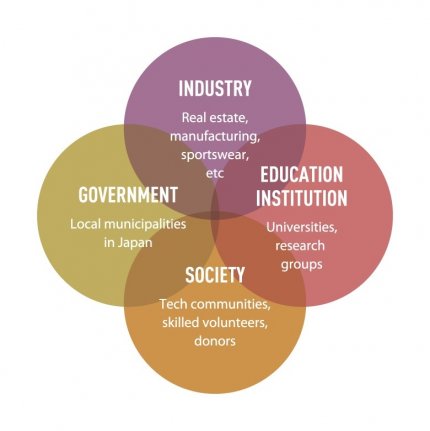Stakeholders’ Engagement for Sustainability in Social Entrepreneurship

Hoe Chin Goi
Professor, NUCB Business School
Kishore Kumar François
NUCB Business School (class of 2022)
This study examines the roles and effects of stakeholders’ engagement in fostering sustainable business model regeneration within the socio-economic framework. Through analysis of the “mymizu” case, we explain the influence of stakeholders’ engagement on business models, and dissect the dimensions of each stakeholder with the quadruple helix model.
Empowering and engaging stakeholders to
regenerate business model for sustainability
Stakeholders’ Engagement for Sustainability in Social Entrepreneurship
The adoption of the Sustainable Development Goals (SDGs) by the United Nations in 2015 (United Nations, 2015) brought sustainability forward as the universal call of act for countries, organizations and individuals. Governments and corporations play a notable part in this movement but cannot always respond to the needs of the people and the planet. To this extent, Social Entrepreneurship (SE) brings innovative solutions to socio-environmental issues. However, social entrepreneurs face numerous challenges and therefore, there is a need to consistently adapt or regenerate their Business Models (BM) with various stakeholders taking on different roles. Thus, this study examines the roles and effects of stakeholders’ engagement on BM regeneration for sustainability in SE from a socio-economic system perspective. Hence, we implement the research question “what is the role of the stakeholders and how does it impact BM regeneration for sustainability in the context of SE?”, from a socio-economic system perspective.
Green Finance as a Catalyst for Sustainable Energy Systems
The journey towards a greener future is underpinned by financial ingenuity and strategic policymaking. The first study examined provides compelling evidence of green finance as a significant catalyst in the energy sector’s shift towards sustainable practices. By examining the energy transformation across regions using advanced analytical tools, the research brings into sharp relief the extent to which green finance initiatives have not just local impact but regional resonance. This ‘contagion effect’ of sustainability, fostered by robust environmental policies and technological innovation, illustrates the complex yet potent relationship between financial mechanisms and the energy sector’s evolution. The study delves into the nuances of this relationship, acknowledging the disparities that can arise in different regions. Such insights are pivotal, as they underscore the need for a multi-faceted approach to green financing—one that accounts for the varied economic, social, and ecological landscapes across which such policies operate.
Why do we need Stakeholders for Social Entrepreneurship?
Moving to the urban sphere, the second study focuses on the environmental quality of cities and how green finance has played a role in shaping it. Through an analysis that spans almost a decade, the findings highlight a tangible improvement in urban emissions reduction following the introduction of green finance policies. This delayed yet significant effect underscores the potential of well-crafted financial strategies to drive environmental change. However, the impact of green finance is not uniform; it exhibits marked regional and industrial heterogeneity. Such findings are critical for policymakers, as they point to the necessity of bespoke financial strategies that align with the specific environmental and industrial needs of each region. By customizing green finance approaches, there is potential to magnify their efficacy, thereby enhancing both local environmental health and broader ecological resilience.
The Spillover Effects of Renewable Energy Policies on the Economy
Recent literature explores how SE can overcome its constraints by leveraging their ecosystem and the interactions within networks of actors and their support activities (Diaz Gonzalez & Dentchev, 2021; Zahra & Wright, 2016). The stakeholder theory’s lens confirms the relevance of society (individuals and communities considered as a network of resources, capabilities, and opportunities (Goduscheit et al., 2021)) as a key stakeholder in SE to deliver social impact. However, social entrepreneurs remain often poor in resources due to a lack of specialization in areas of focus and their over-reliance on social ties for short-term financial support.
Research Methodology
This research applies qualitative analysis on a single case study method (Yin, 2009) of a Japanese social startup, “mymizu”, the first water refill application platform in Japan. It embodies the social missions to reduce the usage of PET bottles by refilling reusable bottles and to drive behavioral change in society by fostering a social movement for responsible consumption. A qualitative content analysis method was employed to investigate the collected data from both primary and secondary data with key stakeholders through semi-structured interviews, fieldwork observations, online publications, and social media of mymizu from 2019 till 2023.
Phenomenon of the “mymizu” case
The finding shows that mymizu could engage every dimension of the stakeholders, which resulted in an increase in awareness of stakeholders and the key competencies of SE over time. Through mymizu, every stakeholder gains awareness on sustainability and responsible consumption, and engages in different ways that contribute to regenerate the BM by providing key resources and competencies to mymizu.
Companies from different industries participate and support mymizu’s movement while the employees see their own awareness and behavior change through the collaborations. Governments have also partnered with mymizu for several projects, such as “Municipal Alliance”, supported by Japan’s Ministry of Environment. Educational institutions, both high schools and universities, are also working together with mymizu to drive behavioural change amongst the students and prompt them to take action as future generations. Communities, making up the society with individual users, support the movement as volunteers who are involved in the human resources, funding donors and technology community for development of the web app.
Quadruple Helix approach for Stakeholders’ Engagement
This phenomenon could be explained by employing the Quadruple Helix (QH) approach, which includes industry, government, educational institutions, and society, as shown in figure 1. The QH concept highlights how the different entities can enable resource exchange, knowledge-sharing and capacity-building (Carayannis & Campbell, 2013) in order to achieve sustainability (Yun & Liu, 2019; Hakeem et al., 2023). This is particularly crucial for SE through increasing awareness and engagement roles of stakeholders that regenerate the BM and result in social impact.
Contributions and Future Research
The study contributed by clarifying the roles of each stakeholder in the four dimensions, including corporations, government, educational institutions and society, in BM regeneration for social impact. The QH approach explains the relevance of the ecosystem that effectively regenerates BM to deliver greater social impact. The study contributes to the theoretical understanding of stakeholder’s engagement by SE relevant for sustainability, and provides a “use case” for educational purposes.
The current study has limitations due to the reliance on a single case study – mymizu for SE in sustainability – which narrows the possibility of generalization. Future studies may apply a longitudinal approach to compare multiple case studies in investigating the stakeholder’s engagement that impacts BM transition through different stages.
References
- Carayannis, E.G. & Campbell, D.F.J. (2013) Mode 3 Knowledge Production in Quadruple Helix Innovation Systems: Quintuple Helix and Social Ecology. In: Carayannis, E.G. (ed.) Encyclopedia of Creativity, Invention, Innovation and Entrepreneurship. New York, NY, USA, Springer. doi:10.1007/978-1-4614-3858-8_310.
- Cummings, J. N. (2004). Work groups, structural diversity, and knowledge sharing in a global organization. Management Science. 50 (3), 352-364. doi: 10.1287/mnsc.1030.0134.
- Diaz Gonzalez, A. & Dentchev, N.A. (2021) Ecosystems in support of social entrepreneurs: A literature review. Social Enterprise Journal. 17 (3), 329-360. doi: 10.1108/SEJ-08-2020-0064.
- Goduscheit, R.C.; Khanin, D.; Mahto, R.V. & McDowell, W.C. (2021) Structural holes and social entrepreneurs as altruistic brokers. Journal of Innovation & Knowledge. 6 (2), 103-111. doi: 10.1016/j.jik.2020.12.001.
- Hakeem, M.M., Goi, H.C., Frendy & Ito, H. (2023) Regional sustainable development using a Quadruple Helix approach in Japan. Regional Studies, Regional Science. 10 (1), 119-138. doi: 10.1080/21681376.2023.2171313.
- United Nations. (2015) Transforming our world: The 2030 Agenda for Sustainable Development. Available from: https://sdgs.un.org/2030agenda [Accessed 15th January 2024]
- Yin, R.K. (2009) Case Study Research: Design and Methods. 4th ed. Thousand Oaks, CA, USA, SAGE Publishing.
- Yun, J. J. & Liu Z. (2019) Micro- and macro-dynamics of open innovation with a quadruple-helix model. Sustainability. 11 (12), 3301. doi: 10.3390/su11123301.
- Zahra, S.A. & Wright, M. (2016) Understanding the social role of entrepreneurship. Journal of Management Studies. 53 (4), 610-629. doi: 10.1111/joms.12149.
Hoe Chin Goi | Faculty | NUCB Business School - MBA Japan
NUCB Business School - MBA Japan
https://mba.nucba.ac.jp/en/faculty/Goi_Hoe_Chin.html

 Brochure
Brochure
 Info Session
Info Session
 Application
Application
 Alumni Voices
Alumni Voices



